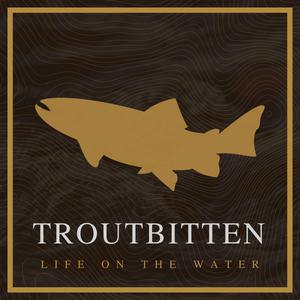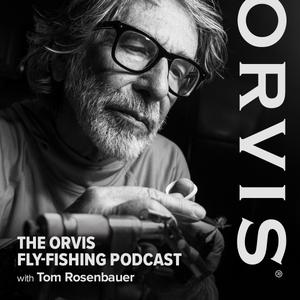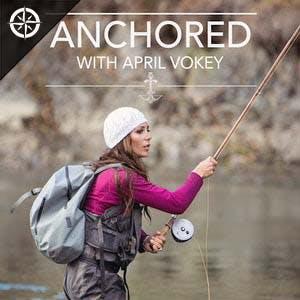
Troutbitten
Domenick Swentosky
Life on the water. Troutbitten is a deep dive into fly fishing for wild trout in wild places. Author and guide, Domenick Swentosky, shares stories, tips, tactics and conversations with friends about fly fishing through the woods and water. Explore more. Fish hard. And discover fly fishing at Troutbitten.com — an extensive resource with 800+ articles about trout, friends, family and the river.
- 43 minutes 49 secondsStreamer Presentations #1 -- What We Control
This season is a ten-part Troutbitten Skill Series, all about Streamer Presentations. We've been looking forward to this one for a long time.
We spend a lot of our time dead drifting dry flies and nymphs. But with streamers, we’re trying to make them look alive. Instead of no motion, we move the fly. And this is exactly why we love to fish streamers. Because we get tired of dead drifting. And we love to think about everything we can do with a streamer to make a trout eat the fly.
A lot of angler say that streamer fishing is salesmanship. That's a great description of the process, because we need to convince the fish that what we’re offering is worth the effort.
But how do we sell it? What are the animations? What are the things we can do with a long fly, to make it look like a baitfish, like a crayfish, a sculpin, maybe a small trout or a fall fish?
This Skills Series will highlight a number of these ways to move the fly. We’ll talk about the Jerk Strip, the Head Flip, Jigging, Speed Leads, Lane Changes, the Crossover Technique, Swinging, Drifting, Gliding, Sliding and more, with dedicated episodes for each.
But, what can we control? Within all of those different presentations, what are the elements that make up a Head Flip, for example? How deep is a streamer during a slow slide? How fast is it going during a Speed Lead? While swinging or drifting, what elements can we adjust and which ones are actually out of our control.
Covering those elements is our goal with this first episode on Streamer Presentations. We’re here to put some details around the things we can control on a streamer.- Head Position (the direction of the fly)
- Depth
- Speed
- And whether we’re holding one seam or crossing seams
Notably, we won’t talk much in this series about flies or even lines and leaders. Because the point is, you can get these motions, these presentations on a wide variety of lines — sinking line, floating line or a Mono Rig. You can use short leaders, long leaders, poly leaders or standard. You can fish it all. But the real question with streamers . . . is how do you want the fly to move?
The joy of streamer fishing is that everything works sometimes. Trout respond to many kinds of presentations out there, and trying to dial that in is a fun way to spend your day.
ResourcesREAD: Troutbitten | Category | Streamers
READ: Troutbitten | Streamer Presentations -- Jigs, Jerks and Strips
PODCAST: Troutbitten | Streamer Presentations -- All About the Head of the Fly
Visit
Troutbitten Website
Troutbitten Instagram
Troutbitten YouTube
Troutbitten Facebook26 January 2025, 10:00 pm - 58 minutes 35 secondsPre-Trip Efficiencies
We're talking about how to shorten your time at the tailgate or the trunk. Just get your waders on, your boots laced, and get to the river. It should be as simple as that, but it’s not uncommon for anglers to waste a half hour or more just getting ready to go fishing.
Most anglers hate this wasted time. In fact, all of this preparation just to go fishing puts a lot of anglers off in the first place. And the colder it is, or the longer you plan to be out there fishing, or the more tactics you plan to use the more all of this pre-trip prep is required.
We want a system for minimizing the time between cutting the car engine to walking away from the vehicle with our fly rod in hand.
Basically, we all just want to go fishing. And the other stuff holds us back.
The full Troutbitten crew is here with me tonight. I’ve fished a lot with every one of them, and I know first-hand that they get out of the starting blocks pretty fast.
ResourcesREAD: Troutbitten | All The Things
READ: Troutbitten | Tip - Don't Rig Up at the Truck
VIDEO: Troutbitten | Splitting The Rod
Visit
Troutbitten Website
Troutbitten Instagram
Troutbitten YouTube
Troutbitten Facebook23 December 2024, 12:00 am - 1 hour 38 minutesTen Years of Troutbitten
We're here to celebrate ten years of Troutbitten.
December 8th was the tenth anniversary of the first article ever published on Troutbitten. All those years ago, I never expected this Troutbitten business — this media company — to become what it is. Honestly, I had no intentions other than to write and publish stories about fishing, simply because I love the process of writing and I enjoyed fishing. I like being creative.
In this episode, we talk about history and upcoming plans. Where has Troutbitten been, and where are we going? We’ reflect on the past, take a look at where we are in the present and talk about some ideas and plans on the horizon.
This whole project has defined my life and career for the last decade, and I know that each of the guys here has their own connection in their own way.
The Troutbitten guys join me, along with the Troutbitten OG, Sloop John B.
ResourcesREAD: Troutbitten | The Last Good Island
PODCAST: Troutbitten | A Troutbitten Glossary
PODCAST: Troutbitten | This is Troutbitten
Visit
Troutbitten Website
Troutbitten Instagram
Troutbitten YouTube
Troutbitten Facebook16 December 2024, 12:00 am - 1 hour 2 minutesBrown Trout, Rainbows, Brook Trout, Cutthroat -- What's the Difference?
This discussion is about the differences between trout species. How are the habits of brown trout different than rainbow trout? Where do brook trout tend to hold and feed vs brown trout? What about cutthroat? Do they have different tendencies or habits than their counterparts?
Because the habits of these trout are different, our target water changes too, as do our fly patterns and our approach.
The guys from the Troutbitten crew join me for a great conversation.
ResourcesREAD: Troutbitten | How To Handle A Trout
PODCAST: Troutbitten | Strategies for Fishing Low and Clear Water
Visit
Troutbitten Website
Troutbitten Instagram
Troutbitten YouTube
Troutbitten Facebook8 December 2024, 11:00 pm - 36 minutes 49 secondsSeason 13 Intermission -- Leader Shop, Videos, Podcast Plans, Books and More
For our Season 13 Intermission, my wife, Becky, joins me for a look at what's going on in the Troutbitten world. We talk about the upcoming leader sale in the Troutbitten Shop (December 6th). We talk about upcoming podcast and video plans, books, fly rods and more.
ResourcesSHOP: Troutbitten | Category | Leaders
Visit
Troutbitten Website
Troutbitten Instagram
Troutbitten YouTube
Troutbitten Facebook4 December 2024, 2:00 am - 1 hour 11 minutesWhy Do Some Rivers Hold Big Trout?
I fished for two decades before I finally realized that not every river, not every creek or stream has big fish. For most of my early days of fishing, I thought there was a different class of fish in some of my favorite waters that I simply never encountered. And I liked to think that if I fished certain ways at certain times, I would finally catch those fish.
But many years later, after more experience and after finally fishing all of the ways that are supposed to help you find the biggest fish — night fishing, streamer fishing, etc. — I also met many like minded anglers and became friends with enough obsessed fishermen whose stories and accounts I could trust. And I realized, no one catches big trout out of some of these waters.
Why do some rivers hold big trout? This is a topic that has come up between all of us on long drives, around the tailgate, and on long walks along the riverbank. Why is it that some rivers just do not have any size to the fish, and then, maybe just the next valley over, not only is the average size larger, but the top tier fish is bigger too?
We're here to talk about it . . .
ResourcesREAD: Troutbitten | Wild vs Stocked -- The Hierarchy of River Trout
PODCAST: Troutbitten | The Hierarchy of River Trout
PODCAST: Troutbitten | Why We All Love Big TroutVisit
Troutbitten Website
Troutbitten Instagram
Troutbitten YouTube
Troutbitten Facebook1 December 2024, 10:00 pm - 1 hour 9 minutesWhy We Fish
Tonight we’re here to talk about why we fish. It’s a simple question. Why do we commit so much of our free time and efforts, our thoughts and our daydreams . . . to fishing?
Why, after all these years, do we keep coming back?
Why, when we could do hundreds of other things — with three hours on a weekday evening or every daylight hour on a Saturday, from dawn to dark — why do we choose to lace up the boots and string up the fly rod?
In all the seasons of this Troutbitten podcast, we’ve often said that fishing, for us, isn’t about hoping to get lucky out there. It’s about making something happen. And surely, the act of fishing is a wonderful draw. But as I talked with the Troutbitten guys a few days ago about this topic of why we fish, it was clear their most important answers really didn’t have that much to do with the actual fishing.
So what we’ll talk about tonight are more of the intangible qualities of fishing. It’s what I think many anglers imagine when they decide to pick up a rod and venture into the woods. Yes, all of us are quickly captivated by the details, the flies, the flows, and the tactic necessary to catch trout. But perhaps for most anglers, it’s that elusive, almost transcendental experience that draws us in today, yesterday and tomorrow. And it’s the same natural pursuit that brought us all down to the water from the beginning.
We’re here to talk about it.
ResourcesREAD: Troutbitten | How To Stay in the Fly Fishing Game for a Lifetime
READ: Troutbitten | We Wade
READ: Troutbitten | Lost Fishing Friends
Visit
Troutbitten Website
Troutbitten Instagram
Troutbitten YouTube
Troutbitten Facebook24 November 2024, 11:00 pm - 1 hour 5 minutesBarbed Hooks or Barbless? Does It Really Matter?
We’re halfway through Season 13, and tonight we have a discussion that’s been on our backburner for quite a while -- barbed hooks or barbless, and does it really matter?
Should we always fish barbless? Maybe not. The answer isn’t that simple. So the Troutbitten guys are here for a conversation and a few thoughts about barbs on hooks.
Each one of us has fished for long enough that we’ve used both barbed and barbless flies. We’ve also used barbs on lures and bait hooks, because we all grew up fishing in different ways. Some anglers who jump right into the fly fishing game — especially for trout — are exposed to a another sentiment. So their reference points are different. And like anything else, what might seem almost outlandish to one person can seem like no big deal to another.
So . . . barbed hooks or barbless? And does it really matter?
ResourcesREAD: Troutbitten | Are We Taking the Safety of Trout Too Far?
READ: Troutbitten | Category | Catch and Release Safely
READ: Troutbitten | Fight Fish Fast
READ: Troutbitten | Nymph Hook Inversion and the Myth of the Jig Hook
PODCAST: Troutbitten | How To Handle a Trout - S1, Ep2
Visit
Troutbitten Website
Troutbitten Instagram
Troutbitten YouTube
Troutbitten Facebook17 November 2024, 11:00 pm - 1 hour 5 minutesFinding Your Confidence Flies
Every angler needs a set of flies to call their own. Among the thousands of patterns, options and choices out there, eventually, we sort out a handful of confidence flies.
Our faith in these flies gives us conviction when choosing them and tying the knot. We’ll fish THIS fly in THIS water. That’s what will catch the next trout. And if it doesn’t, then we’ll change something — maybe the water type, maybe the presentation, maybe the rig. Or maybe we’ll reach for the next confidence fly.
Some anglers have a dozen go-to flies. Others might have fifty patterns, and some carry just a few. But a good set of confidence flies is adapted for the angler, for their water, for their season and their preferences. Most importantly, these flies catch trout.
But how do we find the right flies? How do you find your confidence flies? That’s our topic for tonight, season 13, episode 4.
The Troutbitten guys join me to break all of this down.
Resources
READ: Troutbitten: Category | The Troutbitten Fly Box
READ: Troutbitten | Troutbitten Confidence Flies -- Seventeen Nymphs
READ: Troutbitten | Pattern Vs Presentation
Visit
Troutbitten Website
Troutbitten Instagram
Troutbitten YouTube
Troutbitten Facebook10 November 2024, 10:00 pm - 1 hour 1 minuteThe Ethical Angler -- What Does That Mean?
What's right and wrong? That's what ethics really boils down to. Certainly, there are nuances about how much space to give other anglers on the river or how long we should hold a trout out of the water for a picture. But doing the right thing and being an ethical angler is probably best achieved by asking ourselves one question: Does this action makes things better or worse? And are you helping or hurting the woods, the water, the fish and other anglers?
The best ethics probably happen when no one is looking. And holding ourselves accountable to do the right thing is a reward based in the satisfaction of self-discipline.
There is no handbook for ethics in fishing, of course. And much has been written and discussed on the topic through the years. In this podcast episode, the Troutbitten crew holds a philosophical discussion about ethics in fishing. It's not a list of concrete examples or rules. It's an interesting, thought provoking conversation.
ResourcesPODCAST: Troutbitten | The Ethics of Guiding -- More Harm Than Good?
READ: Troutbitten | Category | Catch and Release Safely
READ: Troutbitten | A Fisherman's Thoughts On Spot Burning
Visit
Troutbitten Website
Troutbitten Instagram
Troutbitten YouTube
Troutbitten Facebook3 November 2024, 9:00 pm - 1 hour 1 minuteThe One or Two Fly Debate, Across Fishing Styles
The Troutbitten guys are here to talk about two flies. Why do we fish two dry flies, two streamers, wets or nymphs? Why don’t we? Why might we fish with just one fly instead? Multiple fly rigs are a common solution to fishing problems, but extra flies on the line can certainly create more issues than they solve.
The one or two fly debate, across fishing styles -- this is our topic. What works, when and why? What’s the upside? What’s the downside?
ResourcesREAD: Troutbitten | Tangle Free Tandem Rigs
READ: Troutbitten | Q&A: Why Do Multi-Nymph Rigs Tangle, and How to Avoid It
READ: Troutbitten | Three Styles of Dry DropperVisit
Troutbitten Website
Troutbitten Instagram
Troutbitten YouTube
Troutbitten Facebook27 October 2024, 10:00 pm - More Episodes? Get the App
Your feedback is valuable to us. Should you encounter any bugs, glitches, lack of functionality or other problems, please email us on [email protected] or join Moon.FM Telegram Group where you can talk directly to the dev team who are happy to answer any queries.
 Wet Fly Swing Fly Fishing Podcast
Wet Fly Swing Fly Fishing Podcast
 Fly Fish Food Shop Talk Podcast
Fly Fish Food Shop Talk Podcast
 Hank Patterson's Outdoor MisAdventures
Hank Patterson's Outdoor MisAdventures
 The Orvis Fly-Fishing Podcast
The Orvis Fly-Fishing Podcast
 Anchored with April Vokey
Anchored with April Vokey